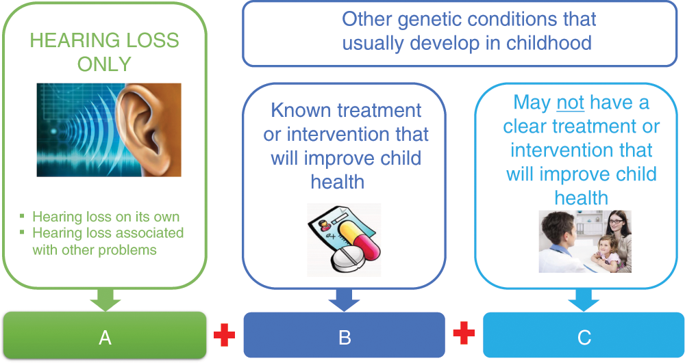当前位置:
X-MOL 学术
›
Genet. Med.
›
论文详情
Our official English website, www.x-mol.net, welcomes your
feedback! (Note: you will need to create a separate account there.)
Exome sequencing in newborns with congenital deafness as a model for genomic newborn screening: the Baby Beyond Hearing project.
Genetics in Medicine ( IF 6.6 ) Pub Date : 2020-01-24 , DOI: 10.1038/s41436-019-0745-1 Lilian Downie 1, 2, 3, 4 , Jane Halliday 2, 4 , Sharon Lewis 2, 4 , Sebastian Lunke 1, 2, 4 , Elly Lynch 1, 2, 5 , Melissa Martyn 2, 4, 5 , Clara Gaff 4, 5 , Anna Jarmolowicz 1, 2 , David J Amor 1, 2, 3, 4
Genetics in Medicine ( IF 6.6 ) Pub Date : 2020-01-24 , DOI: 10.1038/s41436-019-0745-1 Lilian Downie 1, 2, 3, 4 , Jane Halliday 2, 4 , Sharon Lewis 2, 4 , Sebastian Lunke 1, 2, 4 , Elly Lynch 1, 2, 5 , Melissa Martyn 2, 4, 5 , Clara Gaff 4, 5 , Anna Jarmolowicz 1, 2 , David J Amor 1, 2, 3, 4
Affiliation

|
PURPOSE
Genomic newborn screening raises practical and ethical issues. Evidence is required to build a framework to introduce this technology safely and effectively. We investigated the choices made by a diverse group of parents with newborns when offered tiered genomic information from exome sequencing.
METHODS
This population-derived cohort comprised infants with congenital deafness. Parents were offered exome sequencing and choice regarding the scope of analysis. Options were choice A, diagnostic analysis only; choice B, diagnostic analysis plus childhood-onset diseases with medical actionability; or choice C, diagnostic analysis plus childhood-onset diseases with or without medical actionability.
RESULTS
Of the 106 participants, 72 (68%) consented to receive additional findings with 29 (27.4%) selecting choice B and 43 (40.6%) opting for choice C. Family size, ethnicity, and age of infant at time of recruitment were the significant predictors of choice. Parents who opted to have additional findings analysis demonstrated less anxiety and decisional conflict.
CONCLUSIONS
These data provide evidence from a culturally diverse population that choice around additional findings is important and the age of the infant when this choice is offered impacts on their decision. We found no evidence that offering different levels of genomic information to parents of newborns has a negative psychological impact.
中文翻译:

作为新生儿基因组筛查模型的先天性耳聋新生儿外显子组测序:Baby Beyond Hearing 项目。
目的基因组新生儿筛查提出了实际和伦理问题。需要证据来建立一个框架来安全有效地引入这项技术。当提供来自外显子组测序的分层基因组信息时,我们调查了一组不同的新生儿父母所做出的选择。方法 这个来自人群的队列包括先天性耳聋婴儿。为父母提供外显子组测序和有关分析范围的选择。选项为选项 A,仅诊断分析;选择 B,诊断分析加上具有医疗可操作性的儿童期发病疾病;或选择 C,诊断分析加上儿童期发病的疾病,有或没有医疗可操作性。结果 在 106 名参与者中,72 名 (68%) 同意接受额外的调查结果,其中 29 名 (27.4%) 选择选择 B,43 名 (40. 6%)选择选项 C。家庭规模、种族和招募时婴儿的年龄是选择的重要预测因素。选择进行额外结果分析的父母表现出较少的焦虑和决策冲突。结论 这些数据提供了来自不同文化人群的证据,即围绕其他发现的选择很重要,并且提供这种选择的婴儿年龄会影响他们的决定。我们没有发现任何证据表明向新生儿父母提供不同水平的基因组信息会产生负面的心理影响。结论 这些数据提供了来自不同文化人群的证据,即围绕其他发现的选择很重要,并且提供这种选择的婴儿年龄会影响他们的决定。我们没有发现任何证据表明向新生儿父母提供不同水平的基因组信息会产生负面的心理影响。结论 这些数据提供了来自不同文化人群的证据,即围绕其他发现的选择很重要,并且提供这种选择的婴儿年龄会影响他们的决定。我们没有发现任何证据表明向新生儿父母提供不同水平的基因组信息会产生负面的心理影响。
更新日期:2020-01-24
中文翻译:

作为新生儿基因组筛查模型的先天性耳聋新生儿外显子组测序:Baby Beyond Hearing 项目。
目的基因组新生儿筛查提出了实际和伦理问题。需要证据来建立一个框架来安全有效地引入这项技术。当提供来自外显子组测序的分层基因组信息时,我们调查了一组不同的新生儿父母所做出的选择。方法 这个来自人群的队列包括先天性耳聋婴儿。为父母提供外显子组测序和有关分析范围的选择。选项为选项 A,仅诊断分析;选择 B,诊断分析加上具有医疗可操作性的儿童期发病疾病;或选择 C,诊断分析加上儿童期发病的疾病,有或没有医疗可操作性。结果 在 106 名参与者中,72 名 (68%) 同意接受额外的调查结果,其中 29 名 (27.4%) 选择选择 B,43 名 (40. 6%)选择选项 C。家庭规模、种族和招募时婴儿的年龄是选择的重要预测因素。选择进行额外结果分析的父母表现出较少的焦虑和决策冲突。结论 这些数据提供了来自不同文化人群的证据,即围绕其他发现的选择很重要,并且提供这种选择的婴儿年龄会影响他们的决定。我们没有发现任何证据表明向新生儿父母提供不同水平的基因组信息会产生负面的心理影响。结论 这些数据提供了来自不同文化人群的证据,即围绕其他发现的选择很重要,并且提供这种选择的婴儿年龄会影响他们的决定。我们没有发现任何证据表明向新生儿父母提供不同水平的基因组信息会产生负面的心理影响。结论 这些数据提供了来自不同文化人群的证据,即围绕其他发现的选择很重要,并且提供这种选择的婴儿年龄会影响他们的决定。我们没有发现任何证据表明向新生儿父母提供不同水平的基因组信息会产生负面的心理影响。











































 京公网安备 11010802027423号
京公网安备 11010802027423号